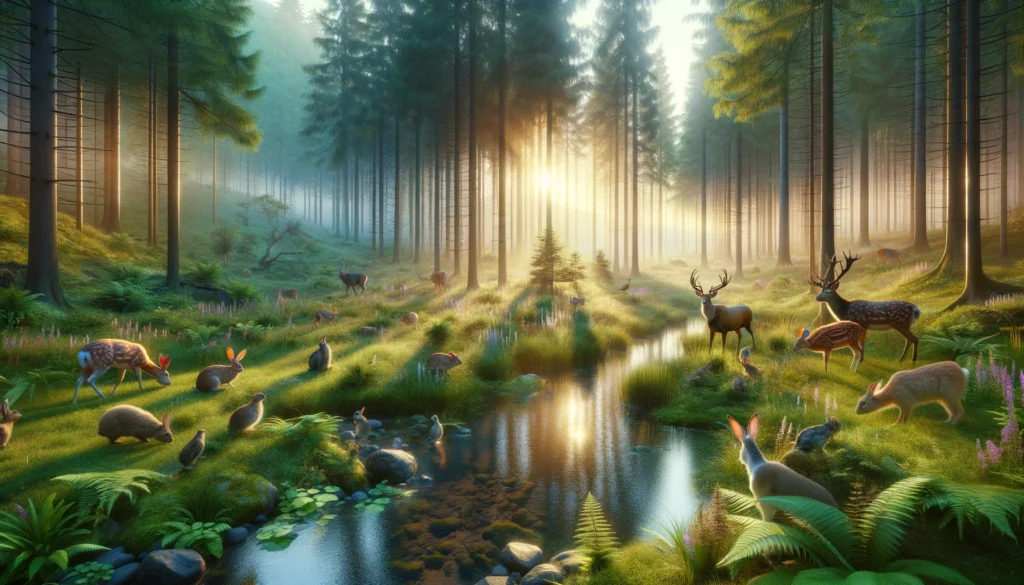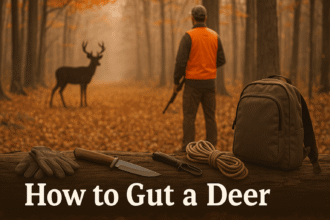The Great Adventure: Hunting Animals in the Forest

Welcome to the untamed wild, a realm where each footfall reverberates with the subtle whispers of nature, narrating the enigmatic story of ‘Hunting Animals in the Forest’. In this guide, we venture profoundly into the forest’s core, succumbing to the primal allure and captivating essence that the world of hunting embodies.
Table of Contents
Introduction
In the silence of the forest, can you hear the heartbeat of the hunt? It’s a rhythm that has echoed through the ages, uniting us with our ancestors in a dance as old as time. But what does it truly mean to hunt in the forest today?
Section 1: The Dawn of Hunting
1.1 Early Humans and Hunting
1.1.1 Tools of the Pri-mitive Hunter
In the beginning, there were simple tools. Picture early humans crafting spears with stones, an invention that marked the dawn of hunting. Here we explore the evolution from rudimentary tools to the sophisticated equipment used today.
1.1.2 Hunting Techniques
Delve into the fascinating history of hunting techniques, from traps and nets to the emergence of stalking and tracking skills that turned hunting into an art.
1.1.3 Rituals and Celebrations
Imagine the fervent celebrations that ensued a successful hunt. Let us take you through the rituals that solidified community bonds and celebrated the respect between hunter and prey.
1.2 Evolution of Hunting Gear
1.2.1 From Bows to Firearms
Embark on a journey through time, observing the transition from bows and arrows to firearms, a revolution that changed the face of hunting forever.
1.2.2 Modern Hunting Apparel
Discover the world of modern hunting apparel, where technology meets tradition to provide hunters with the utmost comfort and protection.
1.2.3 Technological Advancements
In this section, we uncover the marvels of technology in hunting, from GPS devices to drone surveillance, illustrating a new age of hunting.
Section 2: The Ethics of Hunting
2.1 Conservation and Hunting
2.1.1 Sustainable Hunting Practices
Sustainability is not just a buzzword; it’s a commitment. Here we discuss the principles of sustainable hunting practices that ensure the balance of nature is maintained.
2.1.2 Population Control
Explore the critical role of hunting in population control, a mechanism to maintain the delicate equilibrium of ecosystems.
2.1.3 Impact on Ecosystems
What ripple effects does hunting create in the ecosystem? We dissect the positive and negative impacts, creating a nuanced picture of the hunter’s role in the forest.
2.2 Controversies Surrounding Hunting
2.2.1 Ethical Dilemmas
As we venture further, we encounter the ethical dilemmas that stir debate and provoke thought on the hunting grounds.
2.2.2 Hunting Vs. Poaching
Join us as we differentiate between hunting and poaching, shedding light on the stark contrasts that delineate legality and conservation efforts.
2.2.3 Global Perspectives
In this global village, perspectives on hunting vary immensely. We present a riveting discussion encompassing views from different corners of the world.
Section 3: A Hunter’s Guide to the Forest
3.1 Identifying Game Species
3.1.1 Ungulates of the Forest
Step into the silent watch of the forest, where creatures like deer and elk roam with a grace that belies their survival instincts. We explore the lives and habitats of these magnificent beings in this segment.
3.1.2 Bird Game Species
Ever noticed the enchanting symphony of the forest birds? Here, we navigate through the canopies to identify and understand the various bird species that are often the target of hunters.
3.1.3 Small Mammals
Underneath the towering giants of the forest lurk smaller, elusive creatures. In this part, we delve into the fascinating world of small mammals that often become the focus of hunting expeditions.
3.2 Tracking Techniques
3.2.1 Signs of Animal Presence
Reading the signs of the forest is an art. We guide you on how to identify animal tracks, droppings, and other indicators that hint at the presence of game in the vicinity.
3.2.2 The Art of Stalking
Transitioning into the role of a predator involves participating in a ritual as timeless as the forests themselves. In this segment, we will share advice and strategies to hone this skill, consequently guaranteeing a successful and honorable hunt.
3.2.3 Essential Gear
Transitioning from selecting the appropriate clothing to utilizing the latest gear, we offer a comprehensive catalogue and guide that encapsulates all the vital equipment necessary for a safe and satisfying hunting adventure.
Section 4: Immersing in the Hunt
4.1 Preparation and Strategy
4.1.1 Seasonal Hunting Tips
Indeed, timing holds paramount importance in hunting. Initially, we provide invaluable insights into the seasonal trends influencing the movement and behavior of different game species. Consequently, we equip you with the essential knowledge to orchestrate a triumphant hunt.
4.1.2 Choosing the Right Weapon
Indeed, a seasoned hunter recognizes the significance of selecting the appropriate weapon. Consequently, we delve into the myriad options at hand, evaluating their strengths and weaknesses to facilitate a well-informed choice on your part.
4.1.3 Legal Considerations
Within this crucial segment, we delve into the legal frameworks overseeing hunting, underscoring the importance of adhering to responsible and ethical hunting practices that align with the law.
4.2 Experiencing the Hunt
4.2.1 Connecting with Nature
Hunting is more than a pursuit; it’s a profound connection with nature. We delve into the transformative experience of hunting, reflecting on the deeper connections forged in the wilderness.
4.2.2 Personal Growth and Development
Transitioning beyond the mere excitement, there exists an opportunity for personal evolution and maturation. In this segment, we explore the numerous avenues through which hunting can cultivate personal growth, fostering both character and resilience.
4.2.3 Sharing the Experience
At the core of hunting, there exists a vibrant community centered on sharing and connectivity. Furthermore, we urge you to disseminate your experiences, thereby nurturing a community of individuals unified in their fervor for hunting.
Conclusion
As we emerge from the seclusion of the forest, having engaged in “Hunting Animals in the Forest”, we bring back more than just game. We carry narratives, profound experiences, and a fortified bond with Earth. In this culminating segment, we linger for a while, meditating on the essence of our journey and the hunt, and its significance in the broader perspective of life. This reflective segment seamlessly intertwines the various themes explored throughout the article, granting readers a tranquil moment to pause and contemplate deeply.
FAQs
- What are the necessary permits for hunting animals in the forest?
Answer: Before embarking on a hunting expedition, it is imperative to secure the necessary permits to ensure legal and responsible hunting. Permits vary based on regions and game species. Generally, you would need a hunting license and potentially a game tag for certain species. It’s always recommended to check with your local wildlife agency for the most current information. - How can one ensure safety while hunting animals in the forest?
Answer: Safety is paramount when it comes to hunting. It encompasses proper weapon handling, wearing the appropriate attire (like bright orange for visibility to other hunters), and understanding the terrain you are hunting in. Furthermore, it involves respecting wildlife habitats and adhering to the principles of ethical hunting. Undertaking a safety course before the hunting season is always a prudent approach. - Are there any hunting seasons to be aware of?
Answer: Absolutely, hunting seasons are established to allow the harvesting of game during times when they are in surplus and to protect them during their breeding and nesting seasons. It’s crucial to adhere to these seasons to promote conservation and sustainable hunting practices. The exact seasons can vary significantly depending on your location and the species in question. - What are some humane hunting practices?
Answer: Humane hunting practices prioritize the welfare of the animal, aiming to reduce suffering as much as possible. This includes shooting at a close range to ensure a quick kill, aiming for vital organs to minimize suffering, and tracking the animal diligently if it is not killed outright to prevent prolonged distress. - How can hunting contribute to wildlife conservation?
Answer: Hunting can aid wildlife conservation. License fees fund protection programs, help control animal populations, and encourage habitat restoration.







